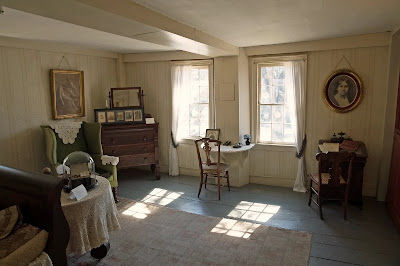I recently ran across a wonderful article in an online travel magazine which showcased former residences of a number of famous American authors. This inspired me to explore the topic further myself during this Holiday Season by creating a list of my own, which also inevitably resulted in my including a couple of authors' residences mentioned in the above-referenced article -- as we bid a "not-so-fond adieu" to 2020.
Some of these residences have been turned into museums, designated as local historical landmarks, placed on the National Register of Historic Places, and are open to visitors.
Herein below is my "short list" -- by no means all-inclusive -- of a few of my own favourite 19th and 20th Century American authors, playwrights and poets, starting with Nobel Prize winner, Pulitzer Prize recipient and champion of the "common man", John Steinbeck.
JOHN STEINBECK (1902-1968)
Steinbeck, whose book The Grapes of Wrath published in 1939, along with the stark, unforgiving photographs of Dorothea Lange, brought to America's attention, and to the attention of then-US President Franklin D. Roosevelt, the dire plight of displaced farmers from the American Midwest during the Great Depression which was exacerbated by the Dust Bowl of the 1930s and which drove many of them to the West Coast, particularly California, seeking a new life.
John Steinbeck was born in Salinas, California in 1902. His birthplace and boyhood home still stands. It is a Queen Anne style Victorian house built in 1897 that the Steinbeck family purchased in 1900 and where they raised their children. It was subsequently purchased in 1973 by The Valley Guild, eight enthusiastic women who shared a common interest in gourmet cooking and who wanted to showcase Salinas Valley produce. The Valley Guild renovated and restored the house after purchasing it, and opened the Steinbeck house to the public as a restaurant on February 27, 1974 —the 72nd anniversary of John Steinbeck’s birth. The residence is located two blocks west of the National Steinbeck Center at 132 Central Avenue in Salinas. which is a "museum of his books".
 |
| John Steinbeck Birth Home in Salinas, California © Snobby Tours®, Inc. All Rights Reserved. |
It was not in his boyhood home, however, but in his final residence in Sag Harbor, New York, that Steinbeck lived from 1955 until his death in 1968. While living there, he wrote several of his best- known novels in a small structure located on the property known as his "writing house", including East of Eden, Zapata, The Winter of Our Discontent, and, of course, Travels with Charley.
 |
| Steinbeck's "Writing House" in Sag Harbor Wikimedia Commons Photo Credit: ©MTmoney, circa 2013 |
 |
| Tennessee Williams residence/Buffie Johnson House Photo Credit: NYC LGBT Historic Sites Project, ©2017 |
 |
| Alcott Family Home known as "Orchard House" Photo Source: Louisa May Alcott's Orchard House Photo provenance unknown. |
 |
| Louisa May Alcott's Bedchamber with built-in writing shelf Photo Source: Louisa May Alcott's Orchard House Photo credit: Trey Powers |
Little Women is based upon Alcott's own family and personal experiences during the harsh years of the American Civil War in the 1860s. The book's timeless humanity is one of the reasons it has endured in popularity well into modern times, continuing to enchant and engage each new generation of readers.
 |
| Harlem Rowhouse occupied by Langston Hughes Photo credit: Christopher D. Brazee NYC LGBT Historic Sites Project, 2016. |
Herein below are some other iconic and famous American writers of the 19th and 20th Centuries whose residences were mentioned in the article that I previously referenced:
EMILY DICKINSON (1830-1886)
Emily Dickinson penned nearly all of her 1,800 poems in her modest room on the second floor of the Dickinson family home in Amherst, Massachusetts, known as "The Homestead", where she was born in 1830 and spent her entire life.
 |
| Dickinson Family Home "The Homestead" Photo source: Wikipedia Commons Photo provenance and credit unknown. |
Now part of the Emily Dickinson Museum, which also includes the frozen-in-time next-door residence of the poet’s brother Austin and his family, The Homestead has been carefully restored to look as it did when Dickinson herself resided there -- from the pale yellow exterior to the floral wallpaper in her bedroom.
The room in which Dickinson did her writing contains one of the poet’s plain white dresses which has a pocket for holding a pencil and scraps of paper. A replica of her tiny square writing desk faces a window overlooking Main Street.
 |
| Emily Dickinson's bedroom/writing room Photo credit: Emily Dickinson Museum |
Dickinson's most prolific creative years were between 1855-1865. Amazingly, none of Dickinson's 1,800 poems penned during her lifetime were published until after her death in 1886.
F. Scott Fitzgerald first met the teenaged Zelda Sayer at a country club dance in 1918 hosted by members of Montgomery, Alabama "society" during World War I, while Fitzgerald was stationed at Camp Sheridan, the nearby army training base. After they married in 1920, the Fitzgeralds lived in New York City and Paris, where they became the "IT" couple, epitomizing the flamboyant and frivolously carefree "Jazz Age" of the 1920s.
 |
| F. Scott and Zelda Fitzgerald Residence in Montgomery, AL Currently the F. Scott and Zelda Fitzgerald Museum Photo credit: The Fitzgerald Museum |
 |
| Interior, Fitzgerald House and Museum Photo credit: F. Scott and Zelda Fitzgerald Museum |

